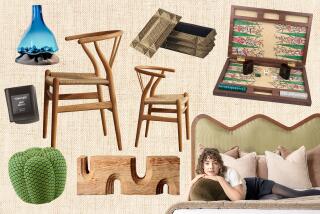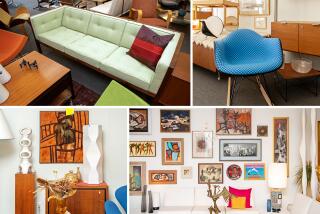Italian Firm Raised Glass to an Art
Glass has been made in Italy for hundreds of years. About 1910, there was new interest in the glassmaking industry. Totally new, modern designs appeared.
The Murano, Italy, glass industry began anew with Carlo Venini in the 1920s. He did away with delicate glass with curlicues and filigree, and turned to plain pieces with clean lines and color. Many creative artists added their designs to the Italian output, and by the 1950s, Murano glass was again famous worldwide.
The glass vases and figurines made since the 1950s are selling for high prices today. A vase can cost several thousands of dollars if it is well-made and by a top designer. Bargains are still to be found because most pieces are unmarked and often unrecognized.
*
Question: I would like to know if dining-room furniture by Jacobean is of value. My set is about 80 years old.
*
Answer: Your set was not made by Jacobean. It was made in the Jacobean style that first became popular in England in the early 1600s. The furniture was made of carved, dark wood. Large balls were often used as feet.
Many of the old styles were redesigned as “ colonial revival” pieces that were suited to the 20th century. Dining-room sets included servers, buffets, large tables and other pieces that would not have been used in the 1600s.
The decorating styles of the 1950s required straight lines and little carving, so the revival styles went out of fashion. They are just returning to favor, and the dining-room sets are selling well. Price depends on quality, importance of the maker and the condition.
*
Q My Irish Belleek teapot is shaped like a shell. It has a black mark on the bottom picturing a dog, a harp and a banner that reads, “Co Fermanagh Ireland.” Underneath, there is a circle with the words, “Deanta in Eirenn.” Can you tell me how old it is?
*
A The mark on your teapot was used on Irish Belleek from 1926 to 1946. Belleek has made the same designs for many years. At least seven marks have been used.
Belleek is a pearly glazed porcelain made in very few factories. The most famous is the Irish firm.
*
Q I have had an Ideal doll named Posie for at least 45 years. I still have the original pink box. Can you tell me when Ideal made the doll and what it’s worth?
*
A Ideal made its original Posie doll, with “magic knee action,” from 1954 to 1956. The doll came in 17- and 23-inch sizes. Posie had a soft vinyl head with rooted saran hair; a hard-plastic body with jointed, bent knees; and flirty, blue sleep eyes. Today the smaller doll sells for $100, and the larger for $125.
*
Q I have a collection of cork-based wooden wine stoppers. Most of them are carved in the shape of men’s heads. All of them are painted bright colors. I have one in the shape of a boy’s body that’s marked “Italy.” It moves when it’s pushed or pulled. When were these stoppers made? What do they sell for?
*
A Most carved stoppers like yours were made in the Black Forest region of Germany during the middle of the 20th century. They were especially popular in the 1950s. They sell for $30 and up at shops and shows. Stoppers with moving parts are the most valuable.
*
Q I collect ring stands and ring trees. They are small dresser dishes with a center pole. Some have branches to hold more rings. I know nothing about their history. Can you help?
*
A Ring stands were made as early as the late 18th and early 19th centuries by Wedgwood, the famous English pottery. Wedgwood’s early ring stands were made of cream-colored earthenware that the pottery called “Queen’s ware.” Ring stands and trees became popular in the United States in the 1930s. They have been sold by many gift ware companies.
*
Q I have my mother’s set of Dirilyte tableware. She had 12 place settings of the gold-colored material. They are solid, not plated. They also seem to be a special type of alloy. Can you tell me about them? Can I put them in a dishwasher?
*
A Dirilyte was made by the Dirilyte Co. of America. The metal alloy was developed in Sweden and introduced in the United States in 1926. Originally, it was called Dirigold, but the patent office was afraid that the name implied gold content. The name was changed to Dirilyte in 1937.
The metal does not tarnish, but do not wash it in the hot water of a dishwasher if it is very old. It will lose its luster.
Since 1961, Dirilyte has had a bonded protective finish that makes it possible to put it in a dishwasher. Production of Dirilyte tableware stopped in 1986.
For a listing of helpful books and publications, include a self-addressed, stamped (55 cents) envelope to Kovels, Los Angeles Times, King Features Syndicate, 235 E. 45th St., New York, NY 10017.
Current Prices
Current prices are recorded from antiques shows, flea markets, sales and auctions throughout the United States. Prices vary because of local conditions.
* California wine label, California Sauterne, Associated Wines Bottled by Associate Wine Co., San Francisco, man and woman toasting glasses, 3 3/4 by 5 inches, $18.
* Griswold bread-stick pan, No. 22, cast iron, 1900, $50.
* Roseville bowl, Moss pattern, No. 291, pink ground, shading to green, marked, 7 7/8 inches, $200.
* Lalique paperweight, “Swallow” No. 1143, 6 1/4 inches, $220.
* Wooden game board, American, 19th century, square, black and mustard-colored blocks, white linear trim, 17 3/4 by 18 inches, $490.
* Buddy Lee doll, plastic, denim jeans, plaid shirt, cowboy hat, boots, 1959-1962, 14 inches, $900.
* Handkerchief mourning the death of General Washington, printed cotton, showing hero on deathbed, physicians, wife, brown on white, 19 by 20 1/2 inches, $1,100.


